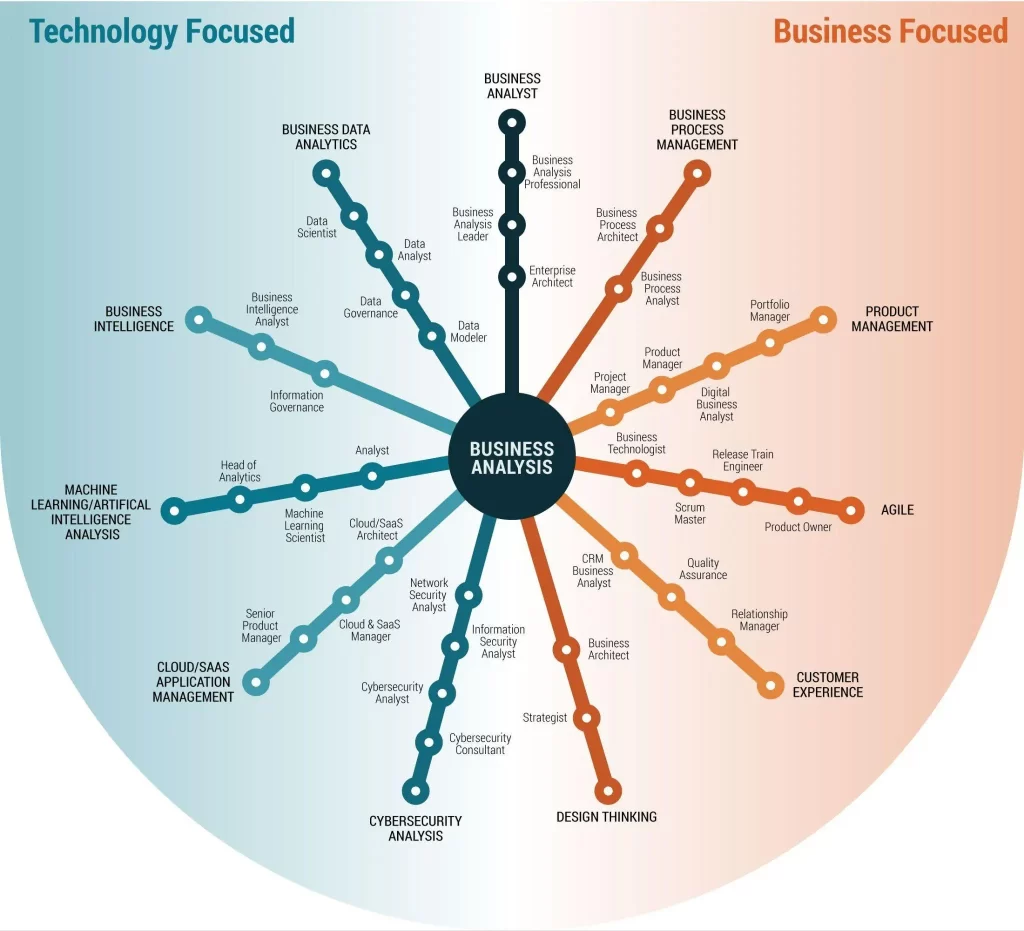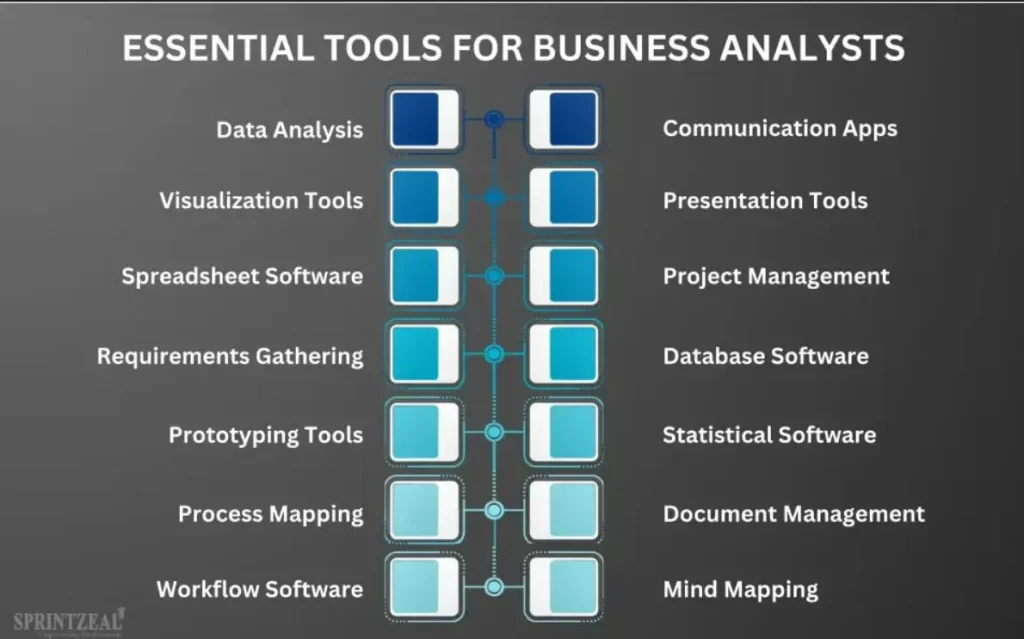How To Become a Business Analyst in 2024 [Step-By-Step Guide]
- -
- Time -

Businesses today are overloaded with data but lacking critical insights. According to McKinsey, up to 40% of corporate reports fail to provide real value, wasting crucial resources. Yet, with data exploding, the demand for insights has never been greater.
Enter business analysts—the data whisperers. Masters of transforming endless numbers into compelling narratives that drive business strategy. The U.S. Bureau of Labor Statistics forecasts 10% more openings for these data whisperers from 2022 to 2032, growth that blows past the average occupation.
But cracking this competitive field takes more than just crunching numbers. You need the complete package—quantitative skills plus instincts for storytelling and strategy.
The good news? This step-by-step guide will equip you with the essential business analyst toolkit for 2024. We’ll show you how to wrangle data and translate it into insights that influence decisions and direction.
Interested in gaining a leading edge for analyst roles? Read on to pick up the skills that turn data into opportunity. Unlock the secrets buried deep in the numbers—become a data whisperer today!
Who Is a Business Analyst?

A Business Analyst acts as the link between what a business wants and the technology solutions that make it happen.
They study how a company operates to deeply understand its needs. What’s working well? What can work better? They dig into the processes behind the scenes.
With that insight, they can then connect the dots to propose smart solutions. The Business Analyst serves as the bridge between identifying challenges and shaping answers to address them.
Their core role is to analyze business operations, find improvement areas, and define technology fixes to achieve goals. They translate “what the business wants” into “how technology can get us there.”
The Business Analyst is a critical facilitator between business vision and making that vision a reality. They grasp the needs and guide the solutions.
Responsibilities of a Business Analyst
A business analyst acts as a bridge between IT and business operations, bringing together technical know-how and strategic vision. Their core responsibility involves making sense of data to drive business decisions and improvements.
Specifically, business analysts are counted on to dig into details, cut through noise, and analyze information to turn out actionable insights. This means pulling numbers apart to spotlight trends and issues. Running ROI calculations to size up how process changes could shake out. Using data to back up recommendations that align with company objectives.
Business analysts also constantly collaborate with both business stakeholders and technical teams. On the one hand, they team up with leadership across departments to drill down into business priorities. This allows them to zero in on analytics and reporting that cater to specific decision-making needs. On the other hand, BAs sync up with developers and engineers to convey business requirements and specs for data tools and solutions.
When new systems or features launch, BAs likewise pivot into an intermediary role. They soak up feedback to pinpoint how well rollouts are moving the needle for different groups. And serve as the connective tissue linking user experience with technical capabilities.
By continuing to interface between all these moving parts, business analysts enable organizations to get on the same data page. They cut down on wasted efforts and guide both business and technical players to uplevel processes. Their specialized mix of analysis, translation, and communication skills makes BAs the glue that seals gaps and helps unearth opportunities.
Educational Background and Qualifications
A strong educational foundation builds critical hard and soft skills for business analysts. Most positions call for at least a bachelor’s degree in a relevant domain like business, finance, economics, or information systems. This introduces fundamental concepts around data, analytics, and business operations to draw from.
While some entry-level business analyst roles may only set the baseline at a bachelor’s, mid-level and senior positions often step up requirements. Leadership or specialized roles tend to expect or prefer candidates to hold a master’s degree as well. Further education concentrates knowledge and elevates analytical abilities to take on more complex organizational challenges.
Yet formal education is only one aspect of qualifying for business analyst success. Hands-on experience that cuts teeth on real-world data, stakeholders, and problems is essential. Aspiring analysts should seek out opportunities like internships or mentorships that offer first-hand exposure to critical thinking and communication aptitudes analysts leverage daily.
It’s this blended balance of education, experience, and credentials that unlocks business analysts’ potential to drill into data and elevate decision-making. The right mix qualifies BAs to cut through noise, synthesize insights across units, and seal divides through skillful communication.
Skills Required to Become a Business Analyst

Here are the skills required to become a business analyst:
- Degree and Domain Knowledge: Formal education builds a broad analytical foundation while concentrating knowledge in a specific business domain. This equips aspiring analysts to drill into data and decisions unique to their chosen sector.
- Analytical Skills: BAs synthesize data from disparate sources to spotlight trends and derive insights. Strong logical thinking and critical analysis abilities are essential to cut through noise and identify underlying performance drivers.
- Negotiation Skills: Liaising between technical and business teams demands sharp negotiation talents to seal divides. BAs must align groups, mediate priorities, and gain buy-in across functions.
- Knowledge of Databases: Understanding database structure, management, and manipulation allows efficient extracting and scrubbing of data for analysis. SQL skills empower drilling into datasets to investigate information.
- Programming: Coding capabilities help BAs automate data collection, analysis, and reporting for continuous insights. Languages like Python and R optimize extracting value from organizational data.
- Data Visualization: Transforming analysis into dynamic graphs, dashboards, and presentations makes communicating insights more compelling and digestible.
- Communication Skills: Whether synthesizing analysis for executives or specifying requirements for engineers, sound communication talents connect BAs’ technical work to business outcomes.
Steps to Become a Business Analyst
This step-by-step guide is designed to provide aspiring individuals with a clear roadmap on how to become a successful Business Analyst in 2024.
Step 1: Decide Your Goal
First, dig into what attracts you to the business analyst career path. Get clarity on domains or specialties like IT, finance, or healthcare that pique your interest. This spotlights areas to sharpen relevant skills and pursue valuable certifications so you can cut through the noise in your chosen sector.
It also allows scoping education plans. While a business, data, or systems bachelor’s degree builds a broad analytical foundation, niche master’s programs concentrate knowledge. For example, an MS in business analytics from schools like Northwestern arms aspiring analysts with specialized data storytelling abilities.
Finally, defining your BA ambitions steers practical experience goals to align with. Seeking analyst-aligned internships and networking with professionals drilling into your desired sector gives invaluable insight.
Step 2: Pursue a Degree
While some analyst roles accept candidates with unrelated degrees, relevant education carries candidates further. Common majors to kick off developing analyst prowess include Information Systems, Computer Science, Business, and Data Analytics.
Technical fields are equipped with data handling competencies to extract insights. Business domains concentrate on desired communication, translation, and strategic planning skills.
But don’t box yourself in! Complementary courses in data visualization, statistics, and analytics still ramp up technical chops. While writing, presentation, and design electives compound abilities to synthesize analysis for stakeholder needs.
Building a blended analytical and interpersonal skill shelf ahead of job-seeking boosts the odds of nailing that first BA gig.
Step 3: Develop Your Business Analysis Skills
Education and coursework shape formal analyst capabilities, but practical development cement proficiency. That’s why hands-on experience remains indispensable for sealing divides between technical data and business teams.
Internships and junior analyst openings that expose you to real stakeholders and scenarios make irreplaceable training grounds. These roles drill into the unglamorous but critical work of gathering, scrubbing, and investigating data. As well as start conditioning how to spot underlying performance drivers and clearly communicate implications.
In smaller or early-stage companies, analysts may even get opportunities to try out solutions or tool recommendations. This tests analytical thinking and grounds recommendations in operational constraints. No textbook can replicate this trial-by-fire or the insights gained into how organizations tap data analytics to inform strategy.
This blend of education and experiential development whips aspiring business analysts into top contenders ready to make immediate impacts in dynamic data-driven roles.
Step 4: Get an Online Business Analyst Certification
While degrees erect a knowledge foundation, certificates showcase specialized capabilities. Condensing curriculum into high-impact essentials, programs like CCS Learning Academy’s Data Analytics & Engineering Bootcamp amplify technical and soft skills in weeks, not years.
Packed with real-world projects and expert mentorship, CCS Learning Academy’s completely online program simulates analyst workflows. Cutting through the noise of raw data to uncover performance drivers and trends. Presenting clear yet comprehensive findings and dynamic visualizations for stakeholder needs.
Exposing aspiring analysts to the latest BI tools and techniques to carry into future roles. Career coaching guides you in spotlighting program learnings when applying to kickstart your BA journey.
Step 5: Gain Practical Real-Time Experience
Classroom learning condenses concepts, but real-time exposure cements competency. Practical analyst experience remains invaluable for sealing divides between data and decision-makers.
Seek out internships, non-profit volunteering, or junior roles focused on data gathering, visualization reporting, and analysis. These opportunities drill into the unglamorous but critical work of scrubbing, investigating, and synthesizing data. As well as conditioning how to spot underlying performance drivers and clearly communicate implications to stakeholders.
In smaller or early-stage companies, junior analysts may even get opportunities to try out solutions or tool recommendations. This tests analytical thinking and grounds recommendations in operational constraints. No textbook can replicate this trial-by-fire or the insights gained into how organizations tap data analytics to steer strategy.
Step 6: Build a Portfolio and Apply for Job
With the right mix of education, experience, and credentials secured, the final step is packaging your analyst appeal. Building an online portfolio highlights capabilities through sample reports, visualizations, and presentations tailored to target analyst openings. This showcases both technical data-wrangling abilities and aptitudes for drilling insights into clear yet comprehensive materials for decision-makers.
Apply for Business Analyst job listings where you can have an immediate analytical impact while continuing to refine your expertise. Analysts become the glue sealing divides across business functions, enabling organizations to get on the same data page while realizing untapped potential.
Job Outlook for Business Analysts
The future looks bright for aspiring business analysts. Employment for BAs is projected to surge 10% from 2022 to 2032 according to the Bureau of Labor Statistics, growth that heavily outpaces the average across all occupations.
Several key factors fuel the amplification of BA roles. As datasets continue expanding exponentially across functions, organizations require dedicated analysts to sift signal from noise. To drill into the overwhelming flow of information now accessible. And synthesize it into insights that propel competitive strategy and decisions.
As data volumes and analytical applications multiply, demand for multi-skilled professionals who can cut through information overload to unearth actionable insights will only intensify. Aspiring business analysts with the right blend of data competency, communication ability, and business acumen are primed to seal persistent divides between technical and executive teams. Enabling organizations to continually optimize performance, forge strategy, and expand potential.
Business Analyst Salary
Competition drives up pay potential for qualified business analysts. On average, BAs rake in $87,688 annually, according to current salary data from Glassdoor. Total compensation, inclusive of bonuses and profit sharing, bumps closer to $93,405 per year.
Several factors account for lucrative earning potential even early in an analyst’s career. Demand for unraveling growing information flows and pinpointing data-driven decisions continues rising across every industry. Yet the supply of professionals packing the specialized analytics abilities plus business acumen to drill into the numbers and extract insights remains scarce. This imbalance compounds organizations’ willingness to pay premiums for analyst talent.
Experience concentrating BA know-how predictably pulls bigger paychecks. After 5 to 10 years of sharpening specialized abilities and honing translations between data and leadership, senior analysts advance closer to $120,000 yearly. High performers with cutting-edge technical expertise like data science or AI proficiency can push even higher.
But business analysts’ earning potential extends past salaries alone. Performance bonuses between $4,000-$8,000 per year are common, given analysts’ visible impacts guiding strategy and operations. Equity compensation also manifests in analysts focused on particularly high-value initiatives or product lines amplifying revenue.
The upshot? Aspiring business analysts have the opportunity to not only do work with a dynamic impact on business performance but be well rewarded for their contributions. Roles that cut through the noise to drill into data, spotlight underlying performance drivers, and seal persistent divides between technical and executive teams remain pivotal across every modern industry.
Conclusion
The verdict is clear – between surging data volumes and the digitization of business, the demand for skilled analysts who can cut through the noise and derive strategic insights has never been greater.
But breaking into the booming field takes more than just number crunching or communication talents alone. This guide has spotlighted the blended balance of education, experience, and capabilities leading business analysts possess. While formal training builds a broad analytical foundation, hands-on exposure concentrates practical abilities and interpersonal skills best.
Still, the learning curve need not be steep or slow with the right program partner. Our Data Analytics Bootcamp training program packs a comprehensive curriculum, usually requiring 4-year degrees, into an immersive 12-week experience. Through real-world projects and dedicated mentoring from analytics veterans, our certificate course condenses the core technical, statistical, and storytelling skills aspiring analysts covet.
So if you’re motivated to drill into the daunting tidal wave of data confronting modern businesses but don’t know where to start, the CCS Learning Academy has you covered. Let our Job Guarantee track fast-track you into this high-impact, high-reward career in months, not years. We’ll equip you with exactly the specialized toolset organizations seek to maximize value from data and optimize decisions through 2024 and beyond.
FAQs
A Business Analyst is a professional who analyzes an organization’s business domain, documents its processes or systems, assesses the business model, and integrates with technology to meet new business objectives. They act as a bridge between stakeholders and IT teams to improve processes, products, services, and software through data analysis.
Typically, a bachelor’s degree in Business Administration, Finance, Information Technology, or a related field is required. However, individuals with degrees in other disciplines can also become Business Analysts if they possess relevant skills and experience.
Yes, essential skills include analytical thinking, problem-solving, effective communication, stakeholder management, an understanding of business processes, and proficiency in data analysis tools. Knowledge of project management and basic IT skills are also beneficial.
Practical experience can be gained through internships, volunteer work, or by taking on business analysis tasks in your current role. Participating in case study competitions or working on personal projects related to business analysis can also provide valuable experience.
Business Analysts should be familiar with data analysis tools (e.g., Microsoft Excel, SQL), project management software (e.g., JIRA, Trello), and diagramming tools (e.g., Visio, Lucidchart) for creating flowcharts and process maps. Familiarity with business intelligence tools like Tableau or Power BI is also advantageous.
Yes, it’s possible to become a Business Analyst without a traditional background in business or IT. Transitioning into business analysis often requires gaining relevant skills, such as through certifications or self-study, and leveraging transferable skills from your previous experiences.
Business Analysts are hired across various industries, including finance, healthcare, IT, consulting, government, telecommunications, and retail. Any industry that seeks to improve processes, systems, or products through data-driven decision-making may hire Business Analysts.
Build a portfolio by including case studies of projects you’ve worked on, highlighting your role, the challenges faced, solutions implemented, and the outcomes. If you’re new to the field, you can include hypothetical projects or detail your analytical approach to solving business problems.
The career path for a Business Analyst can lead to senior roles such as Senior Business Analyst, Business Analysis Manager, or roles in project management, product management, and even consulting. With experience, some Business Analysts transition into related fields like data analysis, business intelligence, or IT management.






